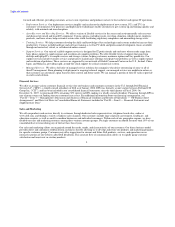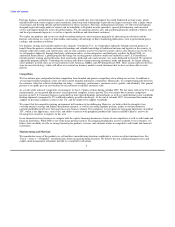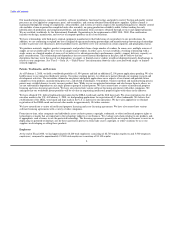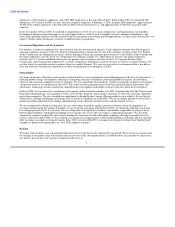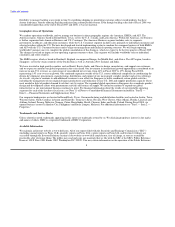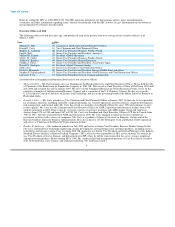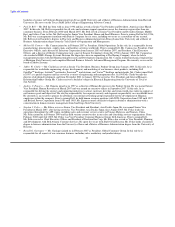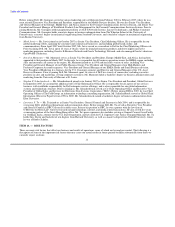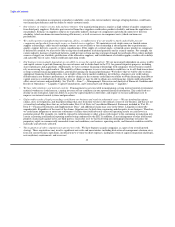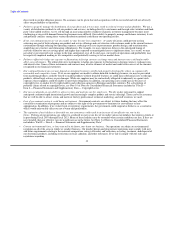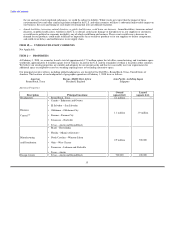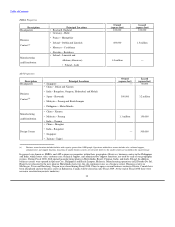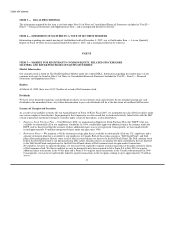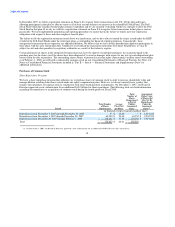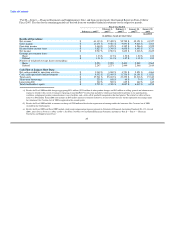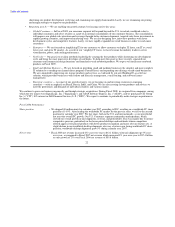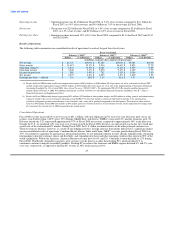Dell 2007 Annual Report Download - page 18
Download and view the complete annual report
Please find page 18 of the 2007 Dell annual report below. You can navigate through the pages in the report by either clicking on the pages listed below, or by using the keyword search tool below to find specific information within the annual report.
Table of Contents
discovered in our due diligence process. No assurance can be given that such acquisitions will be successful and will not adversely
affect our profitability or operations.
• Failure to properly manage the distribution of our products and services may result in reduced revenue and profitability. We use a
variety of distribution methods to sell our products and services, including directly to customers and through select retailers and third-
party value-added resellers. As we sell through an increasing number of indirect channels, inventory management becomes more
challenging as successful demand forecasting becomes more difficult. Our inability to properly manage and balance inventory levels
and potential conflicts among these various distribution methods could harm our operating results.
• If our cost cutting measures are not successful, we may become less competitive. A variety of factors could prevent us from
achieving our goal of better aligning our product and service offerings and cost structure with customer needs in the current business
environment through reducing our operating expenses; reducing total costs in procurement, product design, and transformation;
simplifying our structure; and eliminating redundancies. For example, we may experience delays in the anticipated timing of
activities related to our cost savings plans and higher than expected or unanticipated costs to implement them. As a result, we may
not achieve our expected costs savings in the time anticipated, or at all. In such case, our results of operations and profitability may
be negatively impaired, making us less competitive and potentially causing us to lose market share.
• Failure to effectively hedge our exposure to fluctuations in foreign currency exchange rates and interest rates could unfavorably
affect our performance. We utilize derivative instruments to hedge our exposure to fluctuations in foreign currency exchange rates
and interest rates. Some of these instruments and contracts may involve elements of market and credit risk in excess of the amounts
recognized in our financial statements.
• Our continued business success may depend on obtaining licenses to intellectual property developed by others on commercially
reasonable and competitive terms. If we or our suppliers are unable to obtain desirable technology licenses, we may be prevented
from marketing products; could be forced to market products without desirable features; or could incur substantial costs to redesign
products, defend legal actions, or pay damages. While our suppliers may be contractually obligated to indemnify us against such
expenses, those suppliers could be unable to meet their obligations. In addition, our operating costs could increase because of
copyright levies or similar fees by rights holders and collection agencies in European and other countries. For a description of
potential claims related to copyright levies, see Note 10 of Notes to Consolidated Financial Statements included in "Part II —
Item 8 — Financial Statements and Supplementary Data — Copyright Levies."
• Our success depends on our ability to attract, retain, and motivate our key employees. We rely on key personnel to support
anticipated continued rapid international growth and increasingly complex product and service offerings. There can be no assurance
that we will be able to attract, retain, and motivate the key professional, technical, marketing, and staff resources we need.
• Loss of government contracts could harm our business. Government contracts are subject to future funding that may affect the
extension or termination of programs and are subject to the right of the government to terminate for convenience or non-
appropriation. In addition, if we violate legal or regulatory requirements, the government could suspend or disbar us as a contractor,
which would unfavorably affect our net revenue and profitability.
• The expiration of tax holidays or favorable tax rate structures could result in an increase of our effective tax rate in the
future. Portions of our operations are subject to a reduced tax rate or are free of tax under various tax holidays that expire in whole or
in part during Fiscal 2010 through Fiscal 2021. Many of these holidays may be extended when certain conditions are met. If they are
not extended, then our effective tax rate would increase in the future. See Note 3 of Notes to Consolidated Financial Statements
included in "Part II — Item 8 — Financial Statements and Supplementary Data."
• Current environmental laws, or laws enacted in the future, may harm our business. Our operations are subject to environmental
regulation in all of the areas in which we conduct business. Our product design and procurement operations must comply with new
and future requirements relating to the materials composition, energy efficiency and collection, recycling, treatment, and disposal of
our electronics products, including restrictions on lead, cadmium, and other substances. If we fail to comply with the rules and
regulations regarding
14


